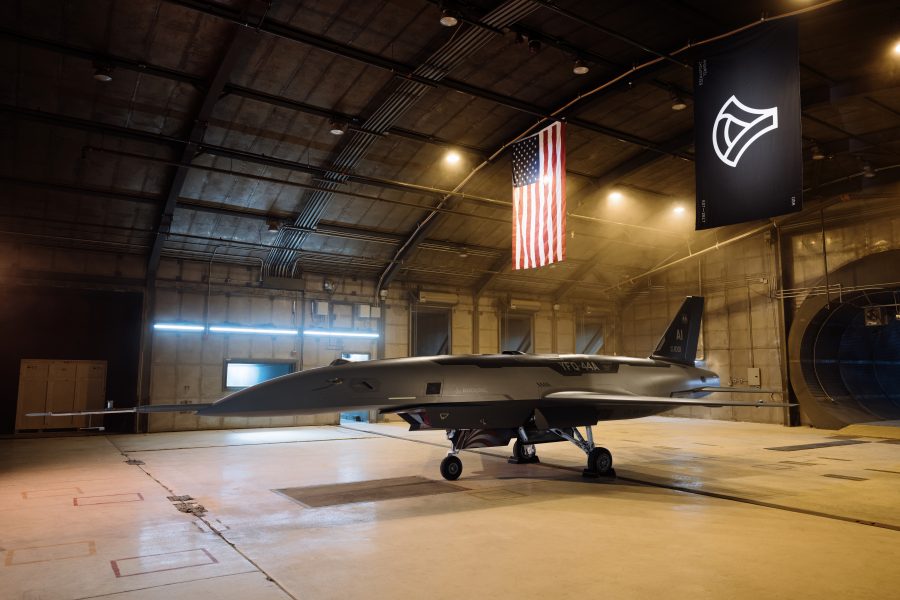The first flight of the Air Force’s YFQ-44 collaborative combat aircraft, which is being developed by Anduril Industries, will likely be delayed because of the ongoing government shutdown, the company’s founder said.
Asked during a media roundtable last week if the lack of a funding deal would delay the first flight of the Anduril’s CCA, Palmer Luckey said, “Certainly; I don’t think I could credibly argue that.” Later, he added in an email, “If the shutdown continues, there could be impacts to our schedule, but we haven’t actually seen that yet.”
The shutdown has led the Department of Defense to furlough many civilians and focus its remaining funding on what it views as essential operations.
Anduril’s CCA is one of two semi-autonomous aircraft the Air Force is developing, with plans for one or both to fly alongside manned fighters in the near future.
The company and the Air Force signaled last month that the first flight would occur soon. At AFA’s Air, Space & Cyber Conference, Air Force Secretary Troy Meink said he expected the flight to occur in mid-October, and Diem Salmon, Anduril’s vice president of air dominance, said the first flight was within “spitting distance.”
But that was before the Oct. 1 government shutdown.
“A lot of stuff moves slower, a lot of stuff stops moving,” Luckey said of the shutdown. “There being a ton of furloughed employees, that’s definitely going to slow things down. It’s frustrating because that’s something that is kind of out of my control. I can’t fund the government, sadly.”
In planning guidance issued Sept. 27, the Defense Department said its priorities for a government shutdown would be to use its remaining funding for continuing operations at the southern border, sustaining deployments in the Middle East, spending on the Golden Dome missile defense initiative, as well as depot maintenance, shipbuilding, and critical munitions. President Donald Trump Oct. 11 said he had directed the DOD to use “all available funds” to continue to pay troops during the shutdown.
Despite the lack of funding, Luckey said he is confident in the aircraft, which is already undergoing ground testing.
Outgoing Air Force Chief of Staff Gen. David W. Allvin said in March he expected the first CCAs—Anduril’s YFQ-44 and General Atomics YFQ-42—to fly sometime over the summer. General Atomics’ CCA flew for the first time on Aug. 27.
Anduril said that its aircraft will be the second CCA to fly because it is designed to be semi- autonomous from the get-go instead of being controlled by a ground control station for early flights, as General Atomics did for its aircraft. Anduril officials say their drone is ahead of schedule, and the Air Force has not suggested the company has missed a deadline to fly.
“We delivered the aircraft in the summer. I think they’re going through a pretty rigorous ground test campaign with it. They’re making sure they know to fuel it, unfuel it, refuel it, ground taxi it—low-speed taxi, high-speed taxi—mounting weapons, unmounting weapons,” Luckey said. “My engineers tell me that if we push the button … it will take off, it’ll fly around, and it’ll come back home. The Air Force is going through a process of evaluation that is very, very reasonable. I think, of course, I would have liked for the test to have happened. Obviously, now the problem is that we’re into the shutdown.”
The nominee to succeed Allvin as Air Force Chief of Staff, Gen. Kenneth S. Wilsbach recently expressed confidence in the CCA program and signaled the first flights of Anduril’s CCA would occur sometime before the end of the year.
“We have a lot of learning to do with these platforms. The first flight just occurred on one of the versions [General Atomics’ YFQ-42]. By the end of the year, we expect the second version [Anduril’s YFQ-44] will have its first flights,” Wilsbach told the Senate Armed Services Committee during his confirmation hearing Oct. 9.
Wilsbach expanded in written answers to questions from the committee, stating that CCAs are “foundational to the Air Force’s future readiness” and said the program is on track with its schedule.
“We are not just prioritizing it, we are aggressively accelerating the fielding of its first increment, with plans in place to initiate the second increment in early [fiscal 2026],” Wilsbach wrote.
“This initiative is pivotal: it leverages cutting-edge autonomy to create a powerful partnership with our crewed platforms, fundamentally reshaping our approach to air superiority,” he added. “Furthermore, CCA are purposefully designed for sustained affordability, driving down lifecycle costs through reduced operational demands, simplified logistics, and lower sustainment. I can confirm the program is currently performing well, meeting all cost, schedule, and performance criteria.”


